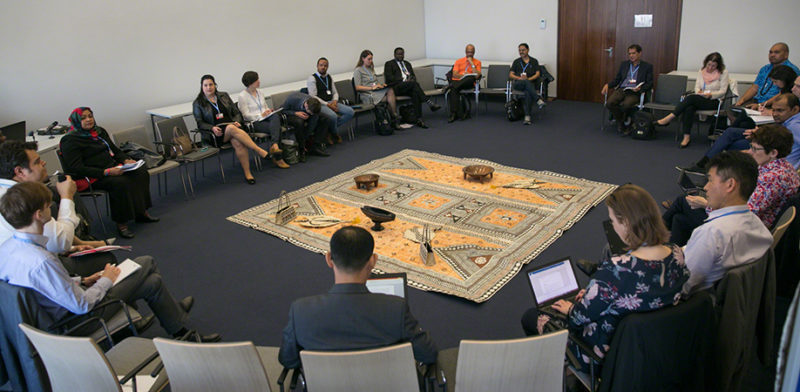The innovative Talanoa Dialogue (TD) took place on Sunday, May 6, 2018 in Bonn, Germany and was sandwiched between the first and second weeks of climate negotiations. After the dialogue everyone was somewhat upbeat about how useful the experience was. Indeed, a delegate from the Democratic Republic of Congo was quoted to have said that the TD offered representatives of countries the space to speak like humans and not as parties (to the United Nations Framework Convention on Climate Change – UNFCCC). Another delegate said that TD was an inclusive and open process creating a new space for international diplomacy. Some said the process should continue beyond COP24.

The TD was a facilitative dialogue proposed by the Fijian President of COP23 to reflect the “Pacific spirit” of “story-telling, problem solving and decision-making for the collective good.” The Dialogue encouraged parties to speak freely to each other on three questions about the global climate crisis: Where are we? Where do we want to go? How do we get there?
Parties and non-state actors including businesses, youths, indigenous peoples, labour, women, and other civil society organisations gathered in three spaces for storytelling, echoing the Pacific pattern of conflict resolution and building consensus.
At the report back session from the Dialogue on Tuesday May 6, the leader of the Nigerian delegation, Dr Peter Tarfa, stated that the TD had a positive outcome and that Nigeria would plan to replicate it at the national level. He stressed that the answer to the question of How do we get there can only be fashioned on trust and transparency.
A Dream Dialogue
On the whole, the fact remained that the dialogue aimed to prepare the hearts of the parties to the hard tasks of negotiations – to bring everyone to the point of hearing one another and understanding that we can only go far when we walk together. It reminds us of the saying by Martin Luther King Jnr that “It may be true that the law cannot change the heart but it can restrain the heartless.” Hopefully the TD could soften some hearts.
While moderating a side event that took place before the TD, Meenakshi Raman of Third World Network, spoke the mind of many observers with regard to the blind side of the TD. She pointed out that a critical question was not on the table and that is how did we get here? That is the question that some parties are unwilling to talk about. It has to do with historical responsibility, with the core principles of the climate convention – that of equity and the common but differentiated responsibility and respective capacities.
Meenakshi Rama further stated: “Asking this question will point to historical emissions responsible for global warming. However, historical responsibility seems like a dirty word that is not being allowed to be mentioned in this space. We cannot ignore the historical perspective.”
The first week of the negotiations had already raised concerns among some delegates with regard to aspects of the Paris Agreement such as: loss and damage, climate finance and the levels of ambition among the industrialised nations. Discussions on the matter of finance were testy as parties looked at how to identify information to be provided by Parties in accordance with Article 9.5. The Article provides that developed countries “shall biennially communicate indicative quantitative and qualitative information” related to the provision and mobilisation of financial resources “including as available, projected levels of public financial resources” to be provided to developing countries.
The Wake of the Dialogue
The report back session from the TD had plenty of bright as well as poignantly dark spots. The bright spots were the many stories of hope, trust, readiness to offer political support and commitment to be fair and to comply. It was also said that indigenous peoples and their knowledge would not be ignored. It was also interesting to hear the presentation of the TD as a storification of the Paris Agreement, with an emphasis on the fact that the story has just started. That makes a lot of sense when it is considered that most of what is being negotiated will only come into effect in 2020, two years down the stormy road.
The dark sports of the Dialogue etched in running conclusions from the various rapporteurs who brought word back from the dialogues. The dialogue on where we are complained that too much attention was paid to technicalities and too little to human values. However, it could actually be said that since voluntary emissions reduction pledges took the place of required emissions reduction based on science, technicalities are actually taking the back seat, except if we are talking of technicalities of semantics.
The TD brought up over 700 stories, but there were running threads in the summaries that should catch our attention. The first was that by 2050 the world should have negative or zero emissions achieved through technologies and forests as carbon sinks. Negative emissions through technologies and forests as carbon sinks imply carrying on with polluting technologies and merely “eliminating” the pollution through sinks. It also suggests that forest dependent communities would be compelled to bear the burden of climate action and get dislocated from Nature’s gifts to them. The second statement said that the question of how do we get there will be answered by technology which was presented as the ultimate solution to tackle global warming.
If those are the takeaways from the Talanoa Dialogue, and if the technologies include geoengineering and the like, it does appear that the stories from the grassroots and from the streets are yet to be heard.
By Nnimmo Bassey
